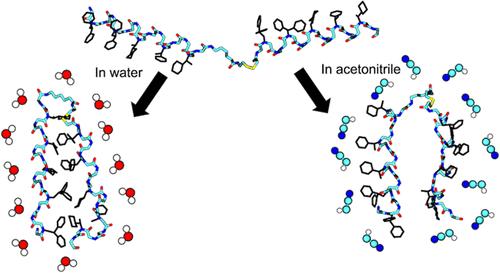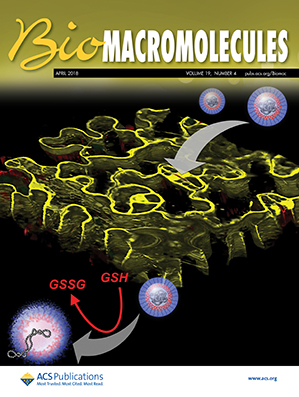Exploration of Tertiary Structure in Sequence-Defined Polymers Using Molecular Dynamics Simulations
IF 5.4
2区 化学
Q1 BIOCHEMISTRY & MOLECULAR BIOLOGY
引用次数: 0
Abstract
Peptoids are a class of sequence-defined biomimetic polymers with peptide-like backbones and side chains located on backbone nitrogens rather than alpha carbons. These materials demonstrate a strong ability for precise control of single-chain structure, multiunit self-assembly, and macromolecular assembly through careful tuning of sequence due to the diversity of available side chains, although the driving forces behind these assemblies are often not understood. Prior experimental work has shown that linked 15mer peptoids can mimic the protein helical hairpin structure by leveraging the chirality-inducing nature of bulky side chains and hydrophobicity, but there are still gaps in our understanding of the relationship between sequence, stability, and particular secondary or tertiary structure. We present a molecular dynamics (MD) study on the folding behavior of these polymers into hairpins, discussing the differences in structure from sequences with various characteristics in water and acetonitrile, and then compare the handedness preference of common helical motifs between solvents.

利用分子动力学模拟探索序列定义聚合物的三级结构
蛋白胨是一类序列确定的仿生物聚合物,具有类似肽的骨架,侧链位于骨架的硝基而不是α碳上。由于可用侧链的多样性,这些材料通过仔细调整序列,展现出精确控制单链结构、多单元自组装和大分子组装的强大能力,尽管这些组装背后的驱动力往往不为人知。之前的实验工作表明,通过利用笨重侧链和疏水性的手性诱导性质,连接的 15 聚丙烯酸酯可以模拟蛋白质的螺旋发夹结构,但我们对序列、稳定性和特定二级或三级结构之间关系的理解仍然存在差距。我们对这些聚合物折叠成发夹的行为进行了分子动力学(MD)研究,讨论了具有不同特性的序列在水和乙腈中的结构差异,然后比较了不同溶剂中常见螺旋图案的手性偏好。
本文章由计算机程序翻译,如有差异,请以英文原文为准。
求助全文
约1分钟内获得全文
求助全文
来源期刊

Biomacromolecules
化学-高分子科学
CiteScore
10.60
自引率
4.80%
发文量
417
审稿时长
1.6 months
期刊介绍:
Biomacromolecules is a leading forum for the dissemination of cutting-edge research at the interface of polymer science and biology. Submissions to Biomacromolecules should contain strong elements of innovation in terms of macromolecular design, synthesis and characterization, or in the application of polymer materials to biology and medicine.
Topics covered by Biomacromolecules include, but are not exclusively limited to: sustainable polymers, polymers based on natural and renewable resources, degradable polymers, polymer conjugates, polymeric drugs, polymers in biocatalysis, biomacromolecular assembly, biomimetic polymers, polymer-biomineral hybrids, biomimetic-polymer processing, polymer recycling, bioactive polymer surfaces, original polymer design for biomedical applications such as immunotherapy, drug delivery, gene delivery, antimicrobial applications, diagnostic imaging and biosensing, polymers in tissue engineering and regenerative medicine, polymeric scaffolds and hydrogels for cell culture and delivery.
 求助内容:
求助内容: 应助结果提醒方式:
应助结果提醒方式:


